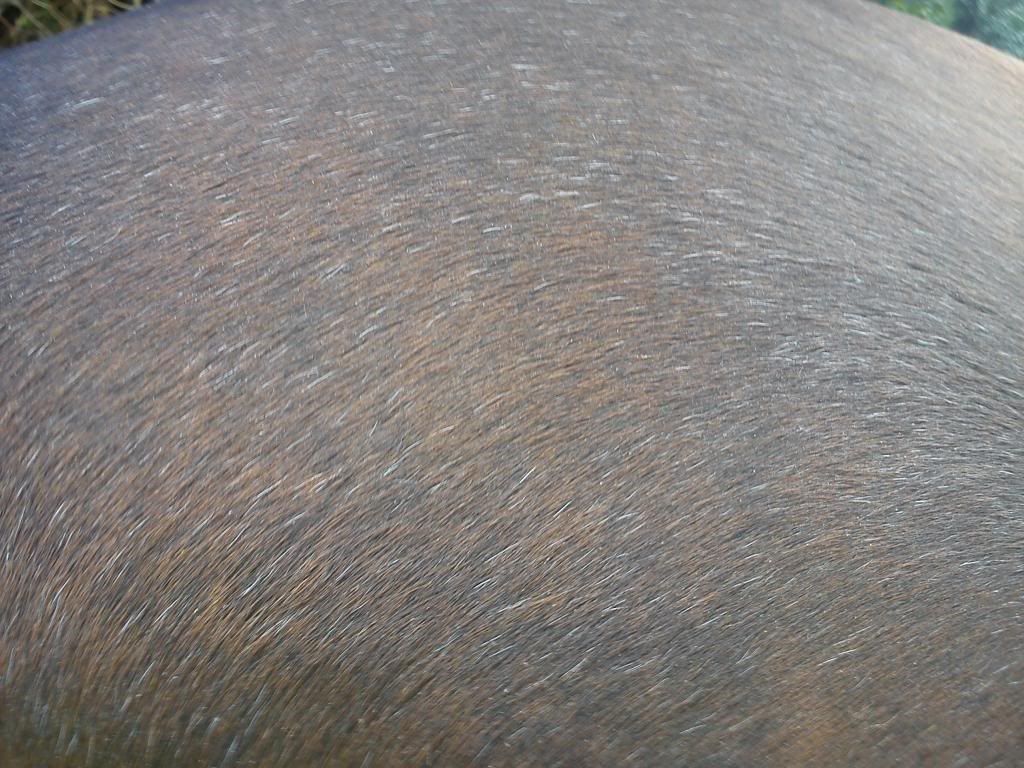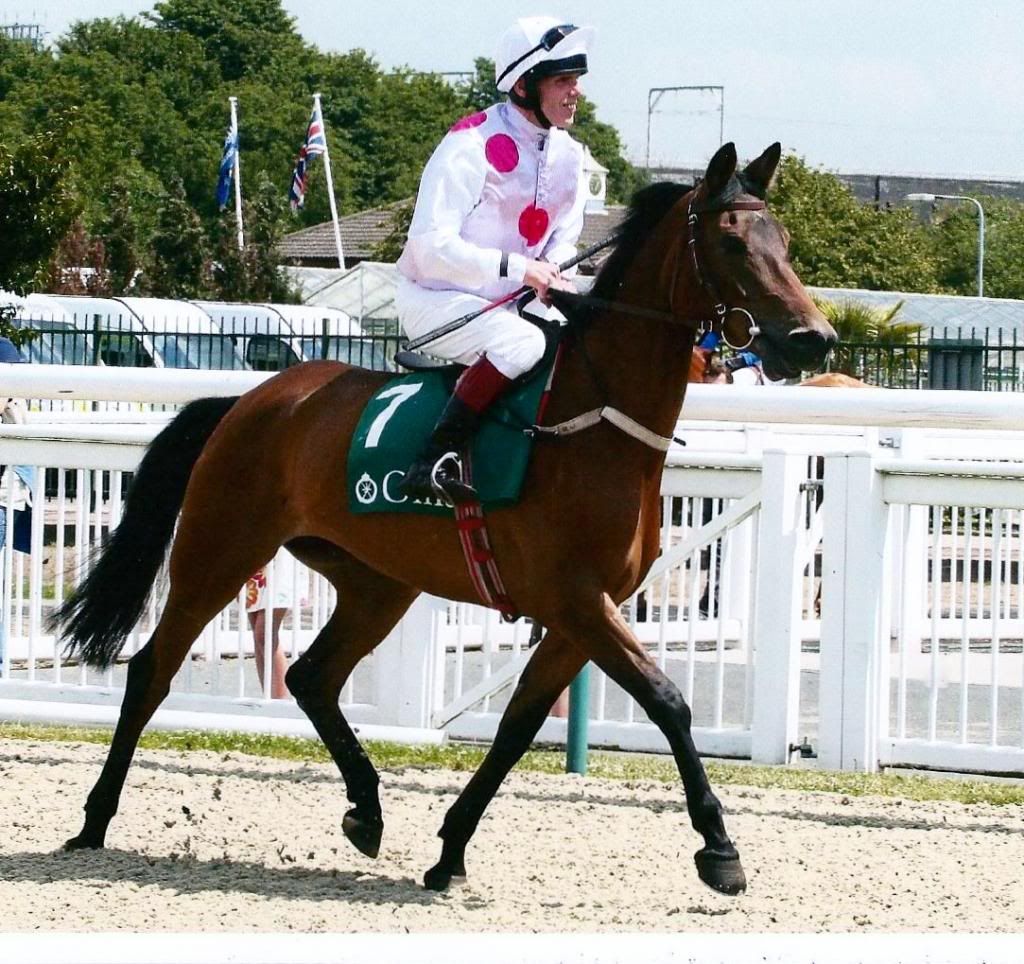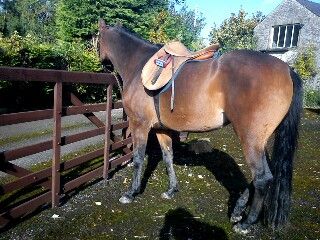| Author |
 Topic Topic  |
|
|
|
adja
Bronze Member
 
97 Posts |
 Posted - 28 Sep 2012 : 4:17:41 PM Posted - 28 Sep 2012 : 4:17:41 PM





|
Hi
My little bay mare seems to be developing grey ticking on her body and hind quarters and she is only 5. I've only just discovered information about the 'rabicano' gene and how this develops and it's something I've not seen before on a bay. However, changes to her coat seem to have developed after her melanomas appeared. They say the grey gene and changes to coat may trigger melanomas - but has anyone had melanomas develop around the same time as Rabicano marking? Just wondering
|
 |
|
Report to moderator
|
|
|
RUTHIE
Gold Member
   

United Kingdom
1238 Posts |
 Posted - 29 Sep 2012 : 08:03:17 AM Posted - 29 Sep 2012 : 08:03:17 AM





|
My bay Crabbet has rabicano flecking. He is only two and half and I will say not heard of a link with melanomas developing....I hope this is not true. I did a topic on identifying rabicano, as I thought he was turning grey.
I will now need to find out if there is a higher % of melanoma re rabicano gene. |
     
In Memory of Crystal Flash 2010-2012 |
Report to Moderator  |
|
|
Callisto
Platinum Member
    

6905 Posts |
 Posted - 29 Sep 2012 : 08:16:10 AM Posted - 29 Sep 2012 : 08:16:10 AM





|
| Our bay high percentage crabbet/100% OE gelding has rabicano flecking, he is 21 and has never shown any sign of melanoma to date. Of course this does not mean it is not possible, but I too have never heard of a link between rabicano and melanoma. |
  Zahkira (GR Amaretto x Taffetta) Zahkira (GR Amaretto x Taffetta)
Linda
East Sussex |
Report to Moderator  |
|
|
Callisto
Platinum Member
    

6905 Posts |
 Posted - 29 Sep 2012 : 08:26:46 AM Posted - 29 Sep 2012 : 08:26:46 AM





|
OK I found this, which implies that while greys are more prone to Melanoma, Rabicano should not be confused with grey, implying that rabicano is no more prone to melanoma than the average horse.
The genetics of gray
The gray gene (G) is an autosomal dominant gene.[1] In simple terms, a horse which has even one copy of the gray allele, even if it has a gene for another coloring, will always become gray. If a gray horse is homozygous (GG), meaning that it has a gray allele from both parents, it will always produce gray offspring. However, if a gray horse is heterozygous (Gg), meaning it inherits one copy of the recessive gene (g), that animal may produce offspring who are not gray (depending on what color gene an offspring inherits from its other parent). Conversely, a gray horse must have at least one gray parent. Genetic testing is now possible to determine whether a horse is homozygous or heterozygous for gray, or if it does not carry the gene at all.[5] The gray gene does not affect skin or eye color, so grays typically have dark skin and eyes, as opposed to the unpigmented pink skin of white horses.[1]
In 2008, researchers at Uppsala University in Sweden identified the genetic mutation that governs the graying process. The study also revealed that gray horses carry an identical mutation that can be traced back to a common ancestor that lived thousands of years ago.[2] The discovery that gray can be linked to a single animal provides an example of how humans have "cherry-picked" attractive mutations in domestic animals.[6]
Gray is controlled by a single dominant allele of a gene that regulates specific kinds of stem cells.[7]
The identification of the gray mutation is also of great interest in of medical research since this mutation also enhances the risk for melanoma in horses; About 75% of grey horses over 15 years of age have a benign form of melanoma that in some cases develops into a malignant melanoma. The study of gray genetics has pointed to a molecular pathway that may lead to tumour development. Both STX17 and the neighboring NR4A3 gene are overexpressed in melanomas from gray horses, and those carrying a loss-of-function mutation in ASIP (agouti signaling protein) had a higher incidence of melanoma, implying that increased melanocortin-1 receptor signaling promotes melanoma development in Gray horses.[6] Both STX17 and the neighboring NR4A3 gene are overexpressed in melanomas from gray horses, and those carrying a loss-of-function mutation in ASIP (agouti signaling protein) had a higher incidence of melanoma, implying that increased melanocortin-1 receptor signaling promotes melanoma development in Gray horses.[6]
Some grays in intermediate stages of graying may be confused with a roan or a rabicano. Some heavily fleabitten grays may also be confused with a roan. However, roans are easily distinguishable from grays: roan consists of individual white hairs on a dark base coat, usually with the head and legs of the horse darker than the rest of the body. Rabicanos also have intermixed white hairs primarily on the body with a dark head. With gray horses, the head is often the first area to lighten, especially around the eyes and muzzle. Also, roans do not lighten with age, while grays always do.
Unless of course someone knows different? |
  Zahkira (GR Amaretto x Taffetta) Zahkira (GR Amaretto x Taffetta)
Linda
East Sussex |
Edited by - Callisto on 29 Sep 2012 08:28:10 AM |
Report to Moderator  |
|
|
RUTHIE
Gold Member
   

United Kingdom
1238 Posts |
 Posted - 29 Sep 2012 : 8:03:51 PM Posted - 29 Sep 2012 : 8:03:51 PM





|
Ahh Callisto, interesting reading. I do not know of anything different. But if there is a high % of grey in the pedigree, does that mean a horse with rabicano gene COULD be susceptible to melanomas?  |
     
In Memory of Crystal Flash 2010-2012 |
Report to Moderator  |
|
|
adja
Bronze Member
 
97 Posts |
 Posted - 29 Sep 2012 : 8:18:36 PM Posted - 29 Sep 2012 : 8:18:36 PM





|
Thanks Linda and Ruthie
It's strange when you think you've got a bay horse then it changes virtually over night... I know what it's like to suddenly start noticing grey hairs but never seen it in a horse before.
My little mare has generations of grey on her bottom line so it's not surprising she's susceptible to the melanoma. But it'd be interesting if anyone else has heard of a bay turning rabacino (oopps that should be rabicano but rabacino sounds more interesting/itallian) and trigering changes so melanoma occurs in younger horses. As your article says Linda, the only established link is with the grey gene and melanomas.
Thanks for your comments and interest in this.
Cheers
Carol
|
 |
Edited by - adja on 29 Sep 2012 8:20:17 PM |
Report to Moderator  |
|
|
RUTHIE
Gold Member
   

United Kingdom
1238 Posts |
 Posted - 30 Sep 2012 : 08:38:12 AM Posted - 30 Sep 2012 : 08:38:12 AM





|
You are welcome, Carol As you say, it is strange to see evidence of a grey in a bay. My Crabbet now has a few grey hairs in his mane. Having said this, I will be very diligent on this now in case he is more susceptible to melanomas. As you say, it is strange to see evidence of a grey in a bay. My Crabbet now has a few grey hairs in his mane. Having said this, I will be very diligent on this now in case he is more susceptible to melanomas. |
     
In Memory of Crystal Flash 2010-2012 |
Report to Moderator  |
|
|
adja
Bronze Member
 
97 Posts |
 Posted - 30 Sep 2012 : 1:48:06 PM Posted - 30 Sep 2012 : 1:48:06 PM





|
I've trawled through loads of research but there doesn't appear to be any link for rabicano. Guess Bloom must have dominant Grey gene plus a rabicano (although she's bay). but there doesn't appear to be any link for rabicano. Guess Bloom must have dominant Grey gene plus a rabicano (although she's bay). |
 |
Report to Moderator  |
|
|
adja
Bronze Member
 
97 Posts |
 Posted - 19 Oct 2012 : 4:41:07 PM Posted - 19 Oct 2012 : 4:41:07 PM





|
Finally found my mobile phone so took a photo of Bloom's coat changing Rabicano - when I bought her last year as a 4 year old there were no signs of grey but with this season's change of coat it is more pronounced. Bizarre!
 |
 |
Report to Moderator  |
|
|
NatH
Platinum Member
    

England
2695 Posts |
 Posted - 22 Oct 2012 : 4:03:18 PM Posted - 22 Oct 2012 : 4:03:18 PM





|
I'm no expert but from this picture your filly looks grey and not bay.
I would love to see a full body and head shot, it would give us more of an idea. |
Natalie
Chapel Lane Arabians
    |
Report to Moderator  |
|
|
adja
Bronze Member
 
97 Posts |
 Posted - 22 Oct 2012 : 5:23:22 PM Posted - 22 Oct 2012 : 5:23:22 PM





|
Hi Natalie
This is the pic taken when she raced at Wolverhampton last season as a 4 year old:

Here is a photo of her now I'm rehabiliting her into a pony for my daughter (taken last week):

Perhaps she's a late developer turning grey! But think it's most likely rabicano...but the melanomas started at the same time as ticking. What do you think? |
 |
Report to Moderator  |
|
|
SuziQ
Gold Member
   
England
922 Posts |
 Posted - 23 Oct 2012 : 08:16:33 AM Posted - 23 Oct 2012 : 08:16:33 AM





|
| That is very bizzare, I guess as you say the change to her very obviously BAY coat is what has triggered the melanoma.. I have had great success with SarcX and do hope that your girls will just drop off soon, she is a lovely looking mare and it will be interesting to see how much she changes! |
Everyone in my life brings me happiness, some by arriving others by leaving. |
Report to Moderator  |
|
|
adja
Bronze Member
 
97 Posts |
 Posted - 23 Oct 2012 : 09:33:29 AM Posted - 23 Oct 2012 : 09:33:29 AM





|
Hi SuziQ
Yes, bizzare indeed.... she certainly is very special too. Apart from being a lovely kind mare, she shares bloodlines with world champ endurance horse winner on her french side and with Sambist on her Russian side. Her bottom line is predominenty grey (Russian ladies going back to Aswan) so guess that's her melanoma link. |
 |
Report to Moderator  |
|
| |
 Topic Topic  |
|

